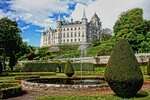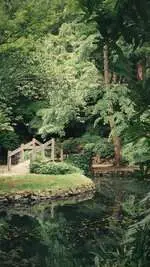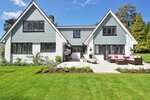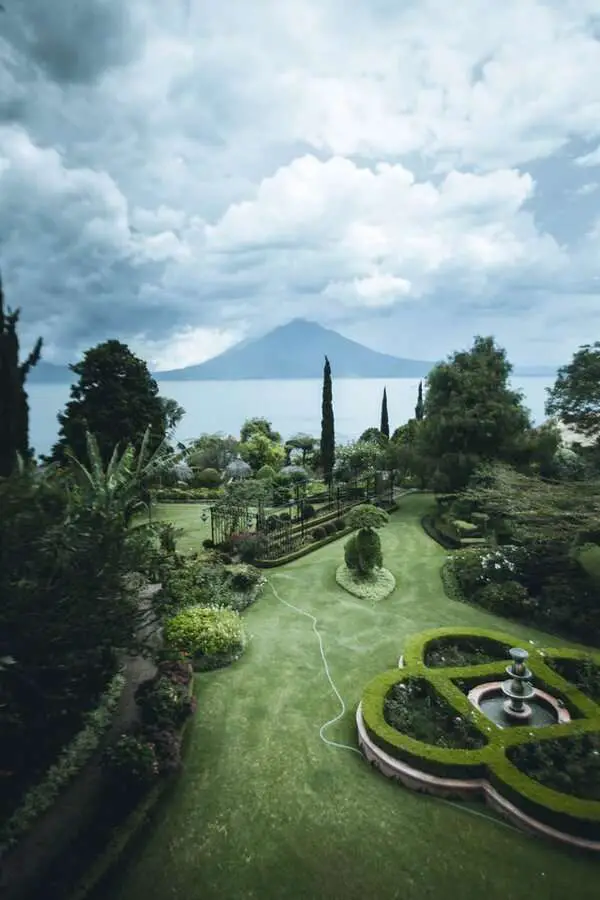Are you thinking of revamping your garden with a do it yourself landscape design? This guide will help you get going with your first-ever project in no time.
All you have to do is think about the location, determine your landscape’s needs and wants, and decide if you wish to sit down and enjoy it whenever you need it.
Which plants are going to be there, and where are you going to place them? Should you get those bed lines or paths in a straight line or a curve? And what about any of those accessories like birdbaths, planters, and benches.
All these questions need to be answered adequately if you want to lay the foundation correctly and carry on building from there.
The key to your do it yourself landscape design is to start small and add new things to your space.
Guide to Landscape Design

What is landscape design? It’s the art of arranging different features of a land area either for practical or aesthetic reasons.
There are two further fragments of this concept. One is a hardscape that includes adding non-living elements, and the other is a soft-scape, which means adding the living elements like flowers, fishes or birds, etc.
Some major ideas of landscape design include harmony, proportion, balance, and transition. Harmony is a way to use different elements to portray a theme. The design needs to be consistent either by mass planting or repetition.
Keep the Balance Right
The balance refers to a comparison of two different landscapes with one and another. Unity is much more focused on a steady theme throughout the area. It is the cohesion across the landscape.
It means that you have to strive for unity but don’t forget about the proportion as well. This refers to the size of a particular item that fits well within the overall landscape.
It can be achieved by proper transition within the size of all the respective components. Unexpected transitions do not show good proportions, and you will not see harmony in such a place.
This transition comes with subtle changes. For instance, if you are looking to use the same flowers in two different parts of the yard, there should be some cohesion to provide you with a smooth transition.
You can do this by adding suitable landscaping all across a vast area. You are just breaking the entries area into small sections for the viewer, so it becomes far easier to digest.
If you understand these concepts and have that aesthetic sense in you, landscape design will become much easier for you to do, and you can even experiment with great results.
What Is Japanese Landscaping, and how to do it yourself?

What’s Japanese landscaping, and how it’s different from the conventional one? This type of landscaping depicts the heavens, and there are places right in the middle of them to enjoy the vista.
The earliest Japanese gardens dated back to the 9th Century and were directly influenced by the Chinese models. Back in 794, when Kyoto was established, only then the Japanese aesthetics began to take form.
These designs came from the Japanese religion Shinto, and the hints included temple gardens, villa gardens, and palace gardens.
In the 12th Century, Chinese influence was back in the design due to Zen Buddhism, and the concept of Zen Garden was born. This concept also had Feng Shui’s principles, a Chinese geomancy system of aligning energy through objects within the landscape and home to achieve balance and harmony.
There are various other conventional Japanese gardens with different design elements and some hints of Western landscaping. These include tea gardens, pond gardens, enclosed gardens, and dry landscape gardens.
This type of landscaping features different paving styles where you will see gravel paths as well as pathways. And a lot of effort is made to make the paths look even and natural. But the general idea is to keep everything harmonious within the landscape.
Japanese maple foliage is available in different colors, and it ranges from bright red to burgundy. Moreover, you can find yellow-green, pink, and deep orange. For Feng Shui, red is highly significant and important in Japanese because it symbolizes vitality, power, and energy.
You can also go for some other autumn shrubs that have a bright hue. These are Amsonia, ninebark, and burning bush. You can opt for moss, especially those that are hanging down from rocks or stones.
Landscape Design for Beginners

Thinking about giving your front yard a makeover? Or want to enjoy a more enhanced beauty of your backyard with some more privacy? It would be better to take some ideas from different project guides. But there are some important points that you need to keep in mind.
You will have to understand the language of landscape design. If you are looking to put something together, you are engaging yourself in designing no matter how humble your design or project is.
The basics are all about color, forms, scale, line, and texture. You have to closely consider these elements in your landscape design, including your hardscape and your softscape. Colors are by far the most interesting and most insightful aspect of landscape design.
There are different types of colors, and they all serve different purposes. Some are better suited for dark areas, while towers are great in brighter environments. Some colors are excellent for highlighting, while others work as neutrals to highlight other colors.
You have to make the right choice based on the design you are thinking about. Which sections do you want to highlight, and which sections need to be in the background? These are some questions that you need to ask while choosing different colors in your garden.
Do it yourself Landscaping Tips
Looking for the best way to beautify your yard? It will be difficult to explain because there are so many different variables working together to Do it yourself landscaping design.
Your budget is one of these variables, your skills are another, and the climate. Even your design tastes and preferences can have different impacts on the overall result of the project.
But here are some tips that you can consider to make sure you get the best results.
- Go for the plants that continue to perform and grow in all four seasons. The primary goal is to have flowers during summer and spring and foliage during fall and winter. This will keep your garden looking extraordinary and changing colors throughout the year.
- Layering the flower beds in different rows is key. The row at the back needs to be the tallest. At the same time, the row on the front needs to be the shortest. Don’t forget to go for repetitions to keep everything in your garden harmonious.
- It would be better for you to create continuity in your do it yourself landscape design projects. With the deciduous trees, you can add more color, diversity, and variety to your garden. But don’t forget about continuity in your gardens and for that, you can go for evergreens.
- Perennial flowers are excellent for planting beds, but they don’t bloom for long. Therefore go for these flowers in May and then in July. They will allow you to plug those gaps in-between.
- Incorporate the hardscape well, and they work better with the evergreens. You can also go for a little flowering around if you want.
- Go for water features that can be the focal point of your space. Birdbaths can work quite well, and your garden may host a never-ending show in the daytime.
- Never ignore the branching patterns of different plants, as they can help you in landscaping as well.
- Always consider going for a low-maintenance yard that doesn’t require much effort from you.
- Also, make sure you go for plants that resist drought very well, and they can outlast summers.
- You have to match your flowers carefully and plant the different types according to their physical specifications and colors.
What Is the Difference Between Hardscape and Softscape?
Hardscape and softscape are two different elements that comprise your outdoor living spaces. These are hardscapes and softscapes.
Hardscape is all the hard stuff in your garden, including bricks, stone, and concrete. On the other hand, softscape involves your garden’s living section, including the trees, the shrubs, and the flowers.
There needs to be a balance between these two elements. But in most cases, different properties might come with more of either of the two aspects.
Hardscaping is beneficial because it prevents any potential erosion and keeps the ground intact. And of course, with soft-scaping, you are creating the looks of your garden.
For the areas that see more sun, the hardscape needs to be more for low maintenance. Simultaneously, softscape needs to be more in areas that see moderate temperatures throughout the year.
Do it yourself landscape design projects
Want to work on do it yourself landscape design projects and looking for some ideas? Here are some useful ideas.
- When you are planting, you need to make sure you are replying with the layers. It would be better to go for peonies, hostas, boxwood shrubs, and similar other flowers.
- You can also make your mulch and use it for your flower beds and tree edges. This might not be the most exciting part if you do it yourself landscape design, but it will surely make your plants healthier.
- You can also make a do it yourself retaining wall, especially if you are struggling with soil erosion within your yard. With such a wall, you can give a solid foundation to the soil to rest on, and your yard will not thin down. It would be better to use interlocking blocks.
- Create a welcoming walkway in your do it yourself landscape design that will be the centerpiece of your garden, and you can welcome your visitors, giving them an impression that the garden welcomes them.
- You can always create some privacy as well, and for that, you will need evergreen trees. Japanese Yew is Italian Cypress that can work well here.
- Lighting your garden up can be a good option as well. Make sure to use LED lights throughout your garden experience, highlighting the important sections in your gardens like the walkway or the flower bed.
- Rock gardens can work great, and you can use a variety of stones and rocks here. Use a water fountain differently to add more character to your landscape.
- You can always dig up some space, add a pond to your garden, and give it a refreshing and lively look.
- If you don’t want to add water in your do it yourself landscape design, you can always add an illusion of water with a dry stream that looks pretty fabulous. You need to dig a trench, line it with your gardens, and fill it with rocks and gravel.
FAQ
What is the cheapest rock for landscaping?
Crushed gravel is the cheapest rock for landscaping. You can also go for pea gravel for this purpose because these two are the cheapest of them all and you can use as much as you need in your garden.
How much does a truckload of river rock cost?
A truckload of river rock costs around $100 to $800 per ton and around $0.05 to $0.35 per pound. So, it’s quite inexpensive to avail as well.
Ordering a truckload of river rocks based on a truck’s 90 cubic feet loading capacity will cost around $2700 to $18,000. An average homeowner buys around 1 ton to 6 tons that might cost around $25 to $1680.
How much does a dump truckload of gravel cost?
Gravel costs around $10 to $50 for each ton. It will cost around $15 to $75 per yard or $1 to $3 per square foot. It will cost around $1350 per truck based on the gravel types, volume, and travel distance. Delivery cost will be included for up to 10 miles.
What software do professional garden designers use?
Professional garden designers use various software based on theory experience and proficiency with the software tool. The most common one is the Pro Landscape Design Software. Some other options are available, such as AutoDesk, DynaScape, SketchUp, iScape, and Punch.
Is Google SketchUp good for landscape design?
Yes, it’s a good tool for landscape design in different ways. You can go 2D to 3D in your model, incorporate an entourage of your property, render your design, and show your property’s context with a larger area.
Wrapping Up
Do it yourself landscape design can be an interesting aspect, but you need to be well versed with its basics if you want to get the best results from it.
You have to understand how different aspects of design work and how they can influence your garden looks. Make sure to go with lots of evergreens because they are going to provide your garden with harmony.
Adding more color with layers or flowers will highlight the sections, and with repetitions, you can add more unity and balance to your design. Also, ensure the balance between different elements as well as soft and hardscaping.


